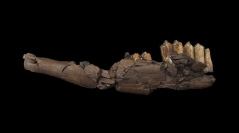

 Comptes Rendus Palevol
16 (7) - Pages 746-761
Comptes Rendus Palevol
16 (7) - Pages 746-761The Guadix–Baza depression (southeastern Spain) preserves one of the best continental Plio-Pleistocene records of the European continent. The new site, Baza-1, is the first Ruscinian locality with fauna of large vertebrates known in the basin. During the summer seasons of 2001, 2002, 2015 and 2016, systematic excavations were undertaken in the site over an area of 25 m2, which provided > 400 fossil remains of Ruscinian mammals. The faunal assemblage is diverse, comprising 17 genera. Rodentia are represented by Ruscinomys sp., Apocricetus barrierei, Debruijnimys julii, Apodemus gorafensis, Castillomys gracilis, Occitanomys cf. brailloni, Paraethomys meini, Paraethomys aff. abaigari, Stephanomys cordii, Trilophomys cf. castroi and Eliomys aff. intermedius. Large mammals are represented by two proboscideans, Anancus arvernensis and Mammut borsoni, the rhino Stephanorhinus sp. cf. S. jeanvireti, the equid cf. Hipparion sp., two bovids, a large sized Alephis sp. and a small-to-middle sized Bovidae indet. (cf. Antilope sp.), and a middle sized deer, Cervinae indet. This record is completed by the presence of a chelonid, Testudinae indet. Biostratigraphic data from micro and macromammals suggest an age for the assemblage between 4 and 4.5 Ma.
Guadix–Baza depression, Pliocene, Mammut borsoni, Anancus arvernensis